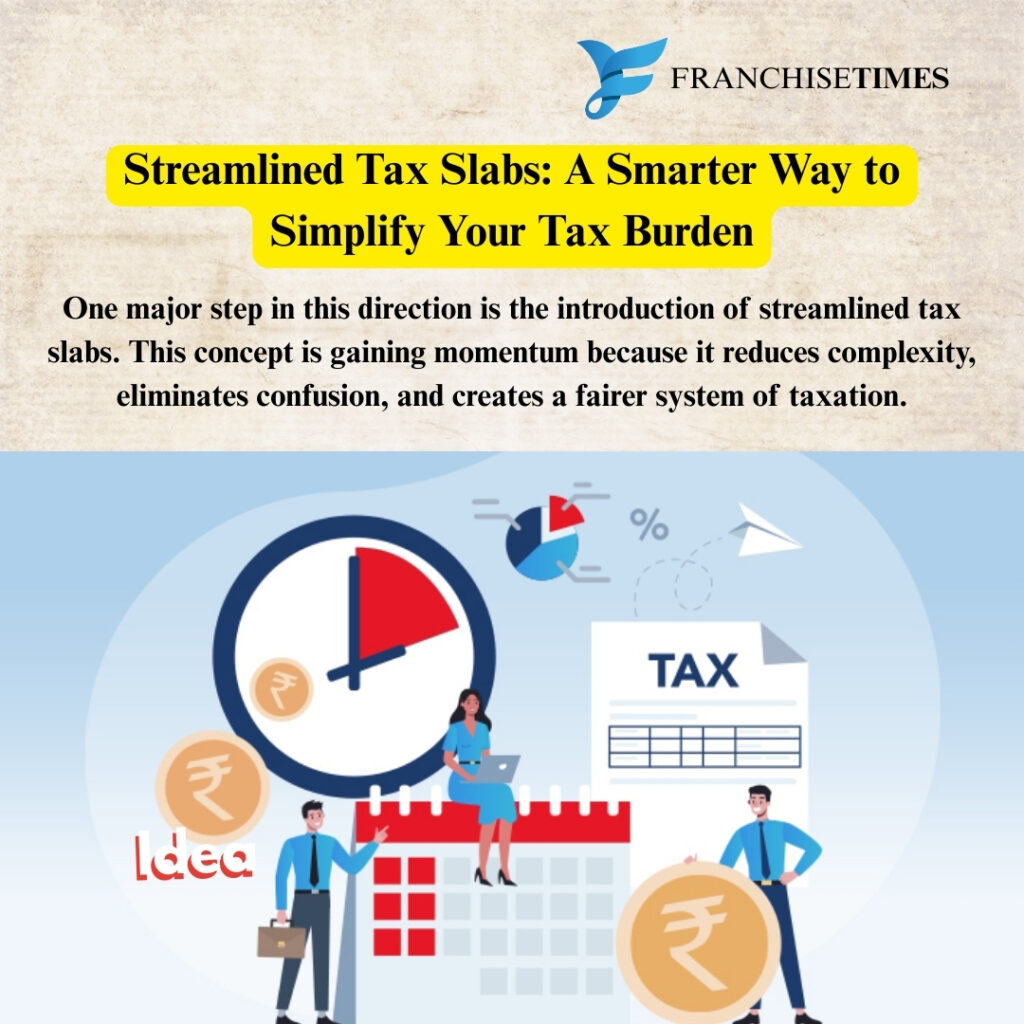Streamlined Tax Slabs: A Smarter Way to Simplify Your Tax Burden
In recent years, governments worldwide have focused on reforming tax structures to make them easier for citizens and businesses to understand. One major step in this direction is the introduction of Streamlined Tax Slabs. This concept is gaining momentum because it reduces complexity, eliminates confusion, and creates a fairer system of taxation. Instead of leaving taxpayers to struggle with multiple exemptions, deductions, and overlapping rates, slabs offer clarity and simplicity.

Whether you are a salaried professional, a small business owner, or an investor, you cannot ignore the impact of these reforms. Tax slabs influence not only how much tax you pay but also how you plan your finances. In this blog, we will explore the meaning of streamlined tax slabs, their advantages, the challenges they address, global practices, and how you can benefit from this simplified approach to taxation.
Understanding Streamlined Tax Slabs in Detail
Taxes have traditionally been viewed as complex. Multiple rates, confusing exemptions, and unclear rules often left taxpayers frustrated. Tax slabs attempt to resolve these challenges by creating a more transparent system. Instead of overwhelming citizens with too many choices, the government defines clear income ranges with straightforward tax rates.
For instance, earlier systems included numerous exemptions under housing loans, medical bills, education expenses, and savings instruments. While they allowed flexibility, they also made the process complicated. Streamlined tax, however, replace those with simple, uniform rates. You pay tax based on your income slab without worrying about complicated paperwork or calculations.
This clarity reduces the chances of mistakes and makes filing returns faster. Moreover, it ensures that both individuals and businesses spend less time interpreting tax laws and more time focusing on growth and productivity.
Another important point is fairness. Streamlined tax slabs distribute the tax burden more evenly across income groups. By applying fewer but clearer rates, the system ensures that high earners contribute more, while middle and lower-income groups benefit from reduced compliance headaches.
Key Benefits of Streamlined Tax Slabs
The concept of streamlined slabs is not just about reducing paperwork. It creates multiple benefits for individuals, businesses, and even governments. Let’s examine some of the most significant advantages:
1. Clarity and Transparency
One of the greatest strengths of tax slabs lies in their simplicity. Taxpayers immediately know which category they fall into and how much they owe. With reduced ambiguity, people feel more confident about their financial responsibilities.
2. Reduced Compliance Burden
Filing taxes can often feel like a daunting task. Streamlined tax remove the need to track endless deductions and exemptions. This results in faster, stress-free filing. In turn, this saves both time and money for taxpayers.
3. Fair Distribution of Tax Burden
When tax slabs are streamlined, the system ensures fairness. Those who earn more naturally fall into higher slabs and contribute a greater share, while lower-income groups are taxed at lighter rates. This balance strengthens trust in the system.
4. Encouragement of Financial Planning
With fewer rules and clear slabs, individuals can plan their finances better. Businesses, too, can project their expenses with accuracy. This encourages smart investments and a forward-looking approach to financial decisions.
5. Better Revenue Collection for Governments
Governments also benefit significantly from streamlined tax slabs. With fewer loopholes and exemptions, revenue leakages reduce. As compliance improves, the state gains steady inflows, which in turn supports infrastructure, healthcare, and education programs.
Challenges in Traditional Slabs and How Streamlined Ones Solve Them
To fully appreciate the importance of tax slabs, it is essential to understand the flaws of traditional systems.
Complexity and Confusion
Traditional slabs often contained numerous deductions and overlapping rates. This led to errors, misreporting, and even unintentional tax evasion. Streamlined tax slabs resolve this by cutting down unnecessary complications.
Inequality in Taxation
Old tax structures sometimes unfairly favored certain groups with excessive exemptions while burdening others. The streamlined model distributes responsibility more evenly across society, creating a sense of justice.
High Administrative Costs
When taxpayers struggled with complicated structures, governments also faced high administrative costs to manage audits, corrections, and disputes. With streamlined slabs, efficiency improves, reducing these expenses.
Limited Financial Literacy
Not all citizens have the expertise to navigate intricate tax codes. Streamlined tax slabs empower even those with limited knowledge to comply without hiring costly consultants.
Encouragement of Loophole Exploitation
In older systems, people often searched for ways to avoid taxes by exploiting gaps. Simpler slabs leave little room for manipulation, ensuring higher integrity in the system.
By addressing these issues, streamlined tax slabs create a modern, efficient, and fair tax environment.
Global Practices: How Countries Use Streamlined Tax Slabs
Tax systems vary across nations, but many countries are embracing the idea of slabs. Each country adapts the concept based on its economy, income distribution, and development goals.
United States
The U.S. tax system traditionally had multiple brackets. However, recent reforms aimed to simplify calculations by reducing the number of categories and standardizing deductions. This approach mirrors the principles of streamlined tax slabs.
United Kingdom
The UK emphasizes progressive taxation with fewer exemptions. Citizens are taxed based on clear income levels, aligning closely with the streamlined philosophy.
Singapore
Singapore is known for its business-friendly tax structure. The nation uses simple, clear slabs to attract foreign investors and encourage entrepreneurship. The streamlined approach has positioned Singapore as a global financial hub.
India
India has recently introduced optional streamlined tax slabs for individuals. Taxpayers can choose between the old regime with exemptions or the new simplified structure. This dual option allows people to experience the benefits of streamlined slabs without losing flexibility.
Nordic Countries
Countries like Sweden and Norway combine slabs with social benefits. Citizens pay slightly higher rates but enjoy excellent public services. The clarity of slabs ensures strong compliance and public trust.
These global practices prove that streamlined tax slabs are not just a trend but a sustainable reform for modern economies.
How to Maximize Benefits Under Streamlined Tax Slabs
Simply knowing about streamlined tax slabs is not enough. You must learn how to adjust your financial strategy to take advantage of this system. Here are some tips:
1. Understand the Structure Thoroughly
Make sure you know exactly which slab applies to you. Study the income ranges and corresponding rates. Awareness is the first step toward better planning.
2. Reevaluate Your Investments
Earlier, many people invested in tax-saving instruments mainly to claim deductions. With streamlined slabs, you can now invest purely for growth and returns rather than just tax benefits.
3. Focus on Real Income Growth
Since deductions matter less, the focus shifts to actual income. Work on enhancing your salary, building side incomes, or improving your business profits.
4. Keep Compliance Simple
Use digital platforms, apps, or online tax-filing services to stay compliant. Slabs are designed to work smoothly with technology, so leverage that advantage.
5. Plan for Long-Term Security
Instead of chasing short-term deductions, start building wealth for long-term goals such as retirement, children’s education, or real estate investments.
By adopting these strategies, you can make the most of streamlined tax and create a secure financial future.
Conclusion
The introduction of Streamlined Tax Slabs is a turning point in taxation. By reducing complexity, ensuring fairness, and simplifying compliance, these reforms create a win-win situation for both taxpayers and governments. Individuals benefit from reduced stress and better planning, while nations enjoy stronger revenue collection and improved trust in governance.
As more countries embrace this approach, streamlined tax slabs will become the global standard for equitable and efficient taxation. For taxpayers, the message is clear: embrace the simplicity, adapt your strategies, and take charge of your financial future.
